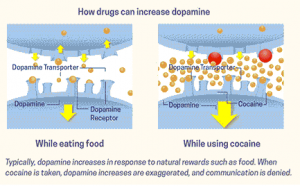The Disease of Addiction
We all have attitudes and judgments that affect how we think about and behave toward others. A major challenge for those who have an addiction is facing and overcoming stigma. Many people believe that addiction is a character flaw or a weakness in a person. They may believe that the alcoholic simply can’t hold their liquor. Perhaps they think that the marijuana smoker just needs to stop. And they are likely to believe the person struggling with methamphetamine abuse should just get over it. Unfortunately, it is not so easy to overcome addiction, and there are many factors that contribute to continuing to use despite the negative consequences.
In fact, the scientific world today, has categorically proven, that when dealing with addiction, we are facing a disease process in the brain that occurs at a chemical level.
The brain registers all pleasures in the same way. It does this through a complicated process, where the way we learn is based on a reward system. Whethe r it is a psycho-active drug, winning the lottery, having sex, or a satisfying meal, our brain rewards us by releasing dopamine, a chemical that makes us feel good. In fact, dopamine is so consistently connected with pleasure that neuroscientists refer to that region of the brain as the “pleasure center”. Different substances affect the pleasure center in different ways. But all substances of abuse, from nicotine to heroin, cause the brain to release much larger quantities of dopamine. This can be 2 to 10 times the amount our brain would normally produce, creating the sense of being “high”.
r it is a psycho-active drug, winning the lottery, having sex, or a satisfying meal, our brain rewards us by releasing dopamine, a chemical that makes us feel good. In fact, dopamine is so consistently connected with pleasure that neuroscientists refer to that region of the brain as the “pleasure center”. Different substances affect the pleasure center in different ways. But all substances of abuse, from nicotine to heroin, cause the brain to release much larger quantities of dopamine. This can be 2 to 10 times the amount our brain would normally produce, creating the sense of being “high”.
Research today has found that not only does dopamine contribute to the experience of pleasure, but it is also directly linked to learning, memory, and motivation. Current understanding of addiction identifies the interaction between dopamine and another neurotransmitter, glutamate, which suggests that the “pleasure reward” system between the two is so strong, that these chemicals can completely take over the brains system of reward-related learning. What this means, is that the user learns faster and with more intensity since the release of dopamine is so much larger.
Since the amount of dopamine released is abnormal, it floods the reward circuit in the brain and overloads it, causing the brain to struggle to regain its usual chemical balance when the substance wears off. After prolonged exposure to the substance, it can lead the brain to stop producing dopamine naturally, creating a physical dependency which causes the abuser to use more just to feel normal.
Because of this learning process, the brains motivational center becomes reorganized, causing nerve cells in the area of the brain involved in planning and executing tasks, to communicate in a way that couples liking something, to needing it, which in turn, motivates us to take action to seek out the source of pleasure. In this sense, the drug has essentially taken over the brain, and the addicted person is no longer in control of their behavior. The abuser loses complete control over the act of seeking out, and taking the substance, no matter what the consequence. This has led to the understanding that in order to effectively treat an addiction, abstinence – total discontinuation of substance use – is necessary.
There is hope. Just as the brain can be re-wired to accommodate the chemical imbalance that occurs from abusing substances, it can also work to restore the complicated systems towards their origin of functioning. At Foothills Centre for Change, we realize repairing damage to the brain incurred from addiction is not an overnight development. This can be a lengthy process that requires much patience, support, and willingness. The National Institute on Drug Abuse suggests residential treatment participation for less than 90 days is of limited effectiveness, and treatment lasting significantly longer is recommended for maintaining positive outcomes.
We are committed to this process and we hope you are too.

